
As a self-proclaimed homebody, I’ve always been fascinated by the power of interior design to transform a space and evoke a certain mood or atmosphere. And when it comes to creating a cozy, inviting ambiance, few elements can rival the impact of a well-designed rug. But did you know that the true magic happens when you start layering rugs?
The Art of Rug Layering: A Game-Changer for Your Decor
Rug layering is a design technique that has the power to completely elevate the look and feel of a room. By strategically placing one rug on top of another, you can inject depth, texture, and dimension into your space in a way that simply can’t be achieved with a single rug alone. It’s like adding an extra layer of warmth and coziness that just draws you in.
Now, I know what you might be thinking – won’t that look cluttered or busy? But trust me, when done right, rug layering can create a beautifully curated and cohesive look that feels both visually striking and incredibly inviting.
Mastering the Layered Rug Look: Key Considerations
To pull off the perfect rug layering look, there are a few key factors to keep in mind. First and foremost, size is everything. The general rule of thumb is to follow a 2/3 or 3/4 ratio – your top rug should be about two-thirds or three-quarters the size of your base rug. This helps ensure a balanced, visually harmonious look that doesn’t feel overwhelmed or unbalanced.
Another important consideration is the pile height of your rugs. Ideally, you want to pair a low-pile or flat-weave rug as your base, with a slightly higher-pile rug on top. This not only helps create a cohesive look, but it also prevents any potential tripping hazards from a overly thick layered setup.
And when it comes to the orientation of your rugs, I generally recommend keeping them aligned – meaning, both rugs should be positioned in the same direction, parallel to your furniture arrangement. This creates a sense of order and intentionality that’s really appealing. The only exception is with hide rugs, which can be placed at a slight angle for a more casual, bohemian vibe.
Rug Layering: A Versatile Design Solution
One of the things I love most about rug layering is just how versatile it can be. Whether you’re working with a small, cozy space or a sprawling open-concept layout, this design technique can be a game-changer.
In a compact room, rug layering can help define different zones and create the illusion of a larger, more expansive space. By placing a smaller, patterned rug on top of a larger, neutral base rug, you can visually delineate the seating area or conversation nook, while still maintaining a cohesive, seamless look.
And in a large, open-concept space, layering rugs can be an effective way to anchor floating furniture and carve out distinct zones – like a cozy reading nook, a lively conversation area, or a formal dining space. The layered rugs help establish a sense of depth and hierarchy, making the space feel more intentional and inviting.
Mixing Patterns and Textures for Maximum Impact
One of the best things about rug layering is the opportunity it presents to play with pattern, texture, and color. When selecting your rugs, don’t be afraid to mix it up! Pair a bold, graphic rug with a more subtle, organic jute or sisal base. Or layer a plush, shaggy rug over a sleek, flat-weave option.
The key is to strike a balance between the two – you want the layers to complement each other, not compete. A good rule of thumb is to keep your base rug fairly neutral and simple, and then use the top rug as a chance to inject some personality and vibrancy.
Rug Layering: A Budget-Friendly Solution
One of the often-overlooked benefits of rug layering is the cost-saving potential. High-quality, room-sized rugs can be a significant investment, often costing hundreds or even thousands of dollars. But by layering a more affordable base rug with a smaller, higher-end rug on top, you can achieve a similar look for a fraction of the price.
For example, let’s say you’ve got your eye on a stunning, patterned rug that’s a bit out of your budget in the size you need. Instead of writing it off, consider pairing it with a large, neutral jute or sisal rug as the base. Not only will this stretch your budget further, but it can also create a more interesting, layered look that elevates the overall design.
Rug Layering: A Timeless, Versatile Approach
As a self-professed lover of all things interior design, I have to say that rug layering is one of my absolute favorite techniques. It’s a surefire way to add depth, dimension, and a cozy, inviting feel to any space – whether you’re working with a compact nook or a sprawling open-concept layout.
And the best part? Rug layering is a timeless, versatile approach that can adapt to your evolving design preferences and needs. As your style changes or your living situation shifts, you can simply rearrange or swap out the rugs to create a fresh, updated look.
So why not give rug layering a try in your own home? Experiment with different combinations of patterns, textures, and sizes, and see how it can transform your space into a cozy, inviting oasis. After all, a well-designed rug can make all the difference in creating a space you truly love.

